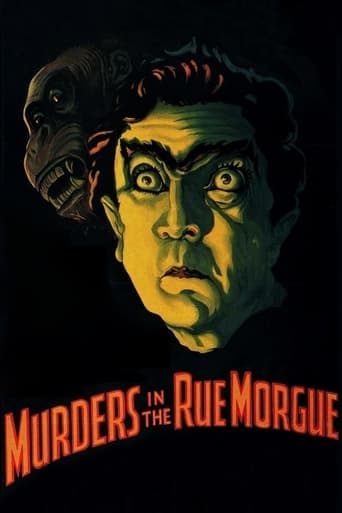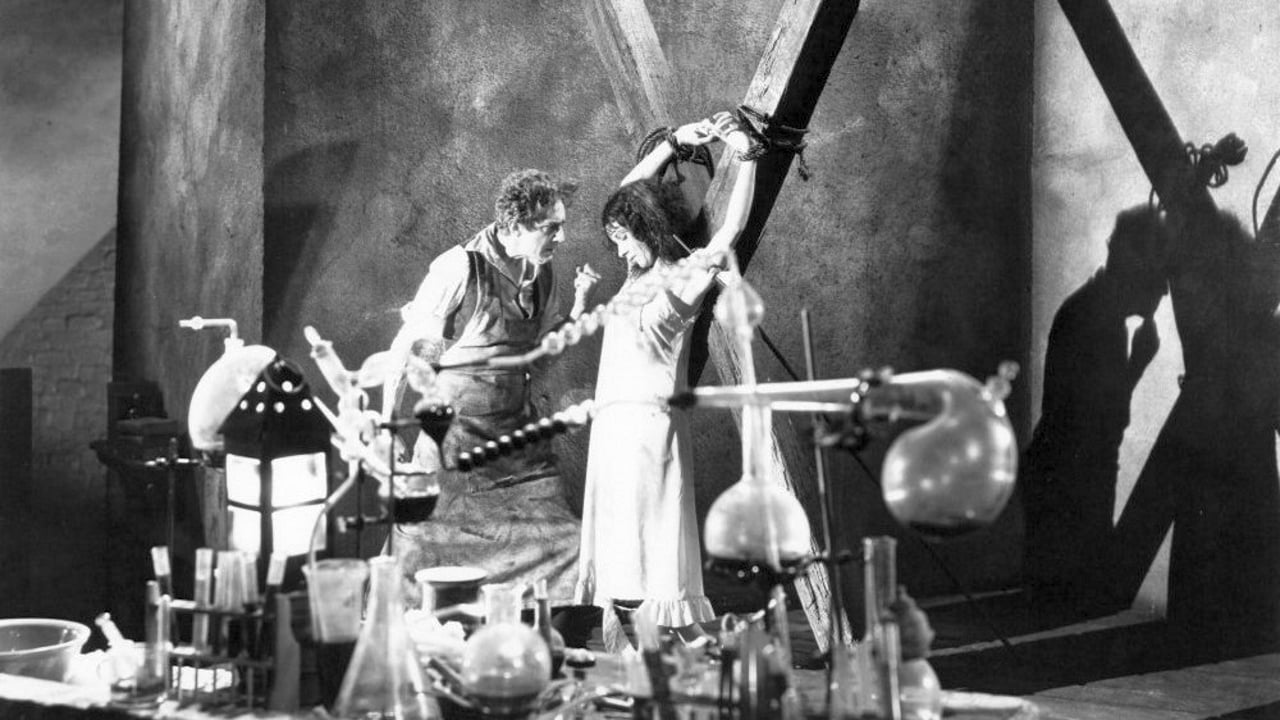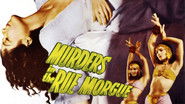Scott LeBrun
"Murders in the Rue Morgue", an adaptation of the Edgar Allan Poe tale, is set in 19th century Paris when a mad scientist named Dr. Mirakle (Bela Lugosi) has an exhibit consisting of a "human"-like ape. Dr. Mirakle spouts some pretty radical ideas about evolution that local carnival goers find blasphemous. But the bad doctor is committed to his pursuit: proving the link between man and ape. So periodically he abducts young women so they may be injected with gorilla blood. His latest target is Camille L'Espanaye (pretty Sidney Fox), whose boyfriend Pierre (Leon Ames) is not a real Dudley Do Right type himself. He's not above bribing a morgue keeper (D'Arcy Corrigan) to let him have access to dead bodies in order to study them. Overall, this isn't one of the most notable Universal horrors of the time. The main problem is that for a movie running only about one hour, it goes on a little long(!), with some scenes that do feel padded, and some comedy relief (supplied by Bert Roach, as Paul, Pierre's roommate) that doesn't really add anything to it. The movie is simply too slow, too quiet (it could have used a music score), and too light on horror too much of the time. Still, it has the look of quality, with appropriate Expressionist cinematography by Karl Freund, and some good atmosphere. In the movies' few shocking scenes, it *does* deliver, and is actually strong stuff for the time, with people getting stabbed, stripped naked and jabbed with a needle, and stuffed up a chimney. These moments do add punch to the movie, but what really elevates the rating by a point is the presence of Lugosi, one genre star who could always be counted on to give 100% to any role; here he delights in the depraved nature of his character. The other actors are okay but can't exactly compare. Erik himself is portrayed with a combination of a human performer in a gorilla suit and closeups of chimpanzees. This may take some viewers out of the movie too much. Given the short duration, the climax naturally feels a little rushed. All things considered, this is worth a look for devoted fans of 30s horror, but isn't as potent as some of the other productions of the time. John Huston is credited with additional dialogue. Seven out of 10.
wes-connors
In 1845 Paris, handsome Leon Ames (as Pierre Dupin) and his rotund roommate Bert Roach (as Paul) take their giggly dates to see carnival attraction Bela Lugosi (as "Doctor" Mirakle) and his monstrous ape "Erik". The ape-man walks upright and is called, "The beast with a human soul!" When pretty Sidney Fox (as Camille L'Espanaye) gets close to his cage, "Erik" seems smitten with Mr. Ames' date and grabs her bonnet. Meanwhile, Mr. Lugosi reveals he is mixing the blood of man and ape to show evolution. We also see Lugosi save streetwalker and future "What's My Line?" panelist Arlene Francis; then, he gives her the needle...Naturally, Lugosi sets his sights on Ms. Fox, and then Ames must try to save her...This is a ridiculous story, and not true to the Edgar Allan Poe original; but, it is interesting and stylish. The common assertion that our simian cousins are "evolving" is still being repeated - usually by those sarcastically seeking to disprove evolution. This is incorrect, of course. Today's apes and humans are not evolving into each other; they merely have a common ancestral tract, which has been shown in ways one could relate to Lugosi's examination of blood in this film. Lugosi's lurid and torturous patient preparation of Ms. Francis and the expressionist sequences photographed by Karl Freund are highlights.******* Murders in the Rue Morgue (2/21/32) Robert Florey ~ Bela Lugosi, Leon Ames, Sidney Fox, Bert Roach
mhesselius
I saw "Murders in the Rue Morgue" when I was just a child in the sixties and wasn't impressed. But now that I've seen the uncut original on Universal's Lugosi collection, I believe "Murders" is one of the most under-rated films from the golden age of horror.Direction by Robert Florey, cinematography by Karl Freund, and art direction by Charles Hall will satisfy the cravings of atmospheric horror fans. And the sources that Florey uses—the Poe story and the silent classic "The Cabinet of Dr. Caligari"—dovetail nicely. What seems rather silly in the Poe story (an ape escapes from a sailor to commit senseless murder) is more plausible and horrific when the ape's owner becomes Dr. Mirakle, a mad scientist intent on proving humans and apes are evolutionary cousins. Why else inject ape's blood into nubile young women if not to find a suitable mate for his side show attraction Erik? I was also impressed by the way director/writer Florey zeroed in on one of Poe's themes. The confusion of tongues scene from Poe's story in which people of different nationalities (ear-witnesses to a murder) mistake the ape's language for unintelligible human speech, demonstrates that humans are no different from Erik, another species of savage primate inhabiting the planet. Seeing Dr. Mirakle talk with Erik and translate for the carnival audience doesn't seem as far-fetched today considering the recent research into primate communication.These thematic elements, together with Lugosi's sinister but surprisingly low-key (for him) performance, and the scene in which Dr. Mirakle injects the street walker with ape blood (Arlene Francis made a good screamer), and in which fiendish assistant Noble Johnson (who made an art of playing such roles) cuts the ropes that bind her Christ-like between crossbeams, releasing her body through a trap door into the river, make this one of the most daring of pre-code horror films.The print Universal included in its Lugosi collection looks fine, much better that the one I saw in the sixties. And neither the bland performances of the romantic leads, nor the man in the ape costume detracts from the over all effect. The inter-cutting between the actual animal and the costumed double is really not that jarring when you consider what was being done elsewhere in this era.
secondtake
Murders in the Rue Morgue (1932)King Kong was released by RKO in 1933, a story of an ape captured by white hairless apes and brought to a foreign land. And this is exactly the beginning of the 1932 Rue Morgue, as Bela Lugosi, playing Dr. Mirakle, appears as flamboyant sideshow impresario with an ape in a cage. His trick (if it is one) is knowing how to translate ape talk to English (or French, maybe, since we are in Paris). His point is that the apes are us, that evolution is true. "Can you understand what he says? Or have you forgotten?" Not the most honorable spokesman for science, no doubt, but he is a mad scientist, and is setting out to create some kind of unexplained human/ape hybrid.The movie is filled with dramatic innovations, and a very high technical standard (for Universal, a minor studio player until this time). And the transfer to DVD is terrific. Ten minutes into the film, Lugosi breaks the fourth wall and looks into the camera to challenge the viewer to accept evolution and its consequences.. (The Scopes trial was 1925, so this is a hot topic.) Watch for the camera attached to the swing about 32 minutes in. There are echoes of Frankenstein (1931) with the madman and his doltish assistant, as well as the angry mobs. And there is Lugosi himself, with all the aura carrying over from his breakthrough in Dracula (also 1931). The cinematography by Karl Freund is totally amazing. There are not astonishing tricks, just consistent, brilliant framing and lighting, scene after scene. (If only he had shot Dracula--oh, he did! Yes...check that out, too.) 1920s German Expressionist films find a true expression here (not Caligari, for sure, but a high water mark for American movies of the time). Simple things like shadows and angles, of course, but also moving camera in subtle ways (the camera falling slightly when approaching someone in a window, for example). Completely first rate.It's common in these movies to have eccentric villains, grotesque monsters, and Gothic settings with wild special effects. And to have the common person as a balance to all this madness. These apply a little comic relief but in a silly way from our perspective. (The "common" person at the time in other movies was far more vivid and timeless, like Crawford or Cagney, but that would overwhelm the villains as well as the budget). In this case, one of the common folk is a resourceful doctor, and this search for the bad guy takes on a larger role than in the other monster movies. The movie isn't a sparkling masterpiece. The acting throughout (even by Lugosi, really) isn't always spot on, but it works overall, and is consistent. There is a comic moment near the end (when we are most anxious for action) where the character have an argument in different languages, and it's so perky I'm assuming they felt they couldn't take it out, but it doesn't advance the plot. It does deal with Logosi's characteristic odd accent. And for fun, there is an anachronism, half an hour in, when a bicycle rides through the little town, decades before they were made like that. It won't matter if you don't believe in evolution. The movie plays loose with the concept, and Dr. Mirakle says at one point, with his beady eyes: "Do you think your little candle can outshine the truth?"


 AD
AD





